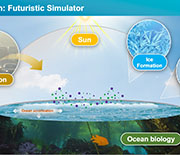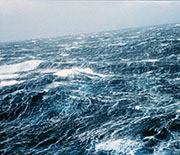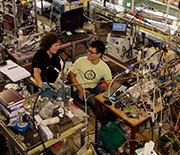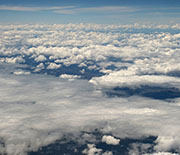News Release 17-109
NSF awards $2.8 million grant to develop advanced ocean and atmosphere simulator
First-of-its-kind simulator will replicate a range of ocean conditions and generate gale-force winds in controlled setting
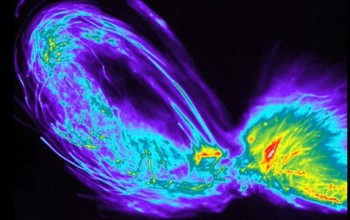
Bioluminescence shines in a wave. In SOARS-like research, scientists studied waves with this light.
November 8, 2017
This material is available primarily for archival purposes. Telephone numbers or other contact information may be out of date; please see current contact information at media contacts.
Can Earth's complex ocean-atmosphere system be mimicked in a laboratory? The National Science Foundation (NSF) has awarded $2.8 million to the Scripps Institution of Oceanography (SIO) in La Jolla, California, to construct just such a replica.
The new Scripps Ocean Atmosphere Research Simulator (SOARS) will accurately duplicate ocean conditions, capturing the interactions of wind, waves, microbial marine life and chemistry in a laboratory setting.
With SOARS, scientists will also explore how the introduction of pollutants by human activities is changing the chemistry of the ocean and the atmosphere, changes that could affect how nature regulates climate.
Researchers will be able to generate winds up to 50 kilometers (31 miles) per hour; control air and water temperatures to replicate conditions ranging from tropical to polar; induce phytoplankton blooms in a range of species; and add inputs such as air pollutants, including greenhouse gases, for studies of potential climate change effects now and in the future.
"This will be the only instrument in the world capable of studying the current and future ocean-atmosphere system, and is a testament to 21st century science," said project principal investigator Grant Deane, a Scripps oceanographer. "We're building the tools we need to understand our changing planet and to educate the next generation of scientists and engineers in whole Earth science."
The team behind SOARS includes an atmospheric chemist, a microbiologist and three physical oceanographers. The experiments planned for the facility are similarly broad and interdisciplinary.
"Research at this new facility will lead to an understanding of how pollutants and higher carbon dioxide levels affect marine animals and plants, cloud formation, and, ultimately, us," said Rick Murray, director of NSF's Division of Ocean Sciences, which awarded the grant. "Through these studies, scientists will simulate how ocean ecosystems ranging from the polar regions to the offshore California current may respond to future environmental conditions."
According to SOARS co-principal investigator Kim Prather, who also directs the NSF Center for Aerosol Impacts on Chemistry of the Environment (CAICE), SOARS will enable more detailed study of aerosols -- particles composed of sea salts, organic matter, viruses and bacteria that are ejected from the ocean surface when waves break and winds blow.
Such particles directly seed and form clouds. Sea-spray aerosols and gases emitted from the ocean can change the properties of clouds, which in turn change the temperature of the planet. Aerosol-cloud interactions are considered to be the most difficult variables in climate to understand.
"Futuristic scenarios can be tested by increasing atmospheric carbon dioxide and pollutant concentrations," said Prather. For example, sunlight and sea-surface pollutants might interact to create new gases and aerosols that could be re-introduced into the atmosphere as toxins with potential health effects.
"SOARS will open doors for the exploration of scenarios that will allow scientists to sort out human-natural interactions at a level that cannot be achieved in the real world."
Another project co-principal investigator, Scripps microbiologist Farooq Azam, said SOARS could lead to an improved understanding of the ocean food web.
"SOARS should help address fundamental questions on the ecology of microbes at the air-sea interface, important for predicting the future state of the ocean-atmosphere system," said Azam.
"The capability of SOARS to simulate controlled ecosystem scenarios will help us understand the mechanisms of variability in the microbial food web, and the significance for the carbon cycle and climate change."
SOARS marks a significant advance in the development of Scripps' environmental simulation equipment. For nearly 50 years, Scripps scientists had been using tanks to generate waves and replicate some ocean processes in the laboratory. The new instrument will continue these experiments in fluid dynamics, physical oceanography and marine engineering.
The total cost of SOARS is $4 million, with $1.2 million provided by Scripps. Design of the instrument has begun, with experiments scheduled to start in 2021.
-NSF-
-
Waves send plumes of sea spray into the atmosphere, altering the formation and duration of clouds.
Credit and Larger Version -
Sun, pollution, cloud droplets, ice formation and ocean biology will be studied at the NSF center.
Credit and Larger Version -
Earth's oceans and atmosphere are inextricably linked in determining how long clouds last.
Credit and Larger Version -
Scripps Institution of Oceanography scientists are at work on instruments for the new NSF center.
Credit and Larger Version -
Clouds' ability to reflect solar energy and absorb radiation affect Earth's climate.
Credit and Larger Version
Media Contacts
Cheryl Dybas, NSF, (703) 292-7734, email: cdybas@nsf.gov
Rob Monroe, SIO, (858) 822-4487, email: rmonroe@ucsd.edu
The U.S. National Science Foundation propels the nation forward by advancing fundamental research in all fields of science and engineering. NSF supports research and people by providing facilities, instruments and funding to support their ingenuity and sustain the U.S. as a global leader in research and innovation. With a fiscal year 2023 budget of $9.5 billion, NSF funds reach all 50 states through grants to nearly 2,000 colleges, universities and institutions. Each year, NSF receives more than 40,000 competitive proposals and makes about 11,000 new awards. Those awards include support for cooperative research with industry, Arctic and Antarctic research and operations, and U.S. participation in international scientific efforts.
Connect with us online
NSF website: nsf.gov
NSF News: nsf.gov/news
For News Media: nsf.gov/news/newsroom
Statistics: nsf.gov/statistics/
Awards database: nsf.gov/awardsearch/
Follow us on social
Twitter: twitter.com/NSF
Facebook: facebook.com/US.NSF
Instagram: instagram.com/nsfgov




